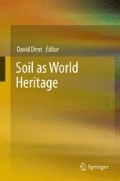Abstract
Experiments were established on Common chernozem in Cahul District to repair the degraded plough layer by enhancing its productivity. After establishing baseline conditions, strips were established with sulla + rye-grass, lucerne + rye-grass and winter vetch as a catch crop for green manure. In parallel, a plot was established with application of 50 t/ha fermented sheep manure. Over 4 years, a mixture of perennial legumes and grasses improved the physical state of the plough layer. A significant improvement of humus content and soil structure was achieved by using vetch as green manure within a 4/5 field crop rotation; with just one harvest of vetch as green manure, the content of soil organic matter increased by 0.19 %, with a parallel improvement of the physical state of the degraded arable layer and a 20–30 % benefit to the following crop.
Access this chapter
Tax calculation will be finalised at checkout
Purchases are for personal use only
Notes
- 1.
Common chernozem and Typical chernozem are both Haplic chernozem in the World Reference Base. In Common chernozem, carbonates occur immediately beneath the topsoil, in the 30–60 cm layer, whereas Typical chernozem is leached of carbonates to below 50–90 cm.
References
Boincean BP (2011) Soil tillage – trends and prospects. Akademos (J Sci Innov Cult Art) 22(3):61–67 (Romanian)
Cerbari V (2010) No-till – a system of agriculture which protects the soil. Mold Agric 8–9:9–14 (Romanian)
Cerbari V (2011) Program for development and implementation of soil conservation technologies in agriculture. Mold Agric 4–5:7–9 (Romanian)
Cerbari V (coordinator) and others (2010a) Monitoring of soil quality. Database, conclusions, prognoses, recommendations. Pontos, Chisinau
Cerbari V, Scorpan V, Taranu M (2010b) Decreasing СО2 emissions from arable land of the steppe zone of the Republic of Moldova. Environment (Sci J Inf Ecol Cult) 49(1):6–13 (Russian)
Shein EV, Milanovsky EY (2002) Soil organic matter and aggregate stability. In: Proceedings of the international conference on soils under global change, Constanta, Romania, vol 1, 3–6 September 2002
Author information
Authors and Affiliations
Corresponding author
Editor information
Editors and Affiliations
Rights and permissions
Copyright information
© 2014 Springer Science+Business Media Dordrecht
About this chapter
Cite this chapter
Cerbari, V., Scorpan, V., Ţaranu, M., Bacean, I. (2014). Phyto-technology for Remediation of Chernozem in the South of Moldova. In: Dent, D. (eds) Soil as World Heritage. Springer, Dordrecht. https://doi.org/10.1007/978-94-007-6187-2_37
Download citation
DOI: https://doi.org/10.1007/978-94-007-6187-2_37
Published:
Publisher Name: Springer, Dordrecht
Print ISBN: 978-94-007-6186-5
Online ISBN: 978-94-007-6187-2
eBook Packages: Earth and Environmental ScienceEarth and Environmental Science (R0)

